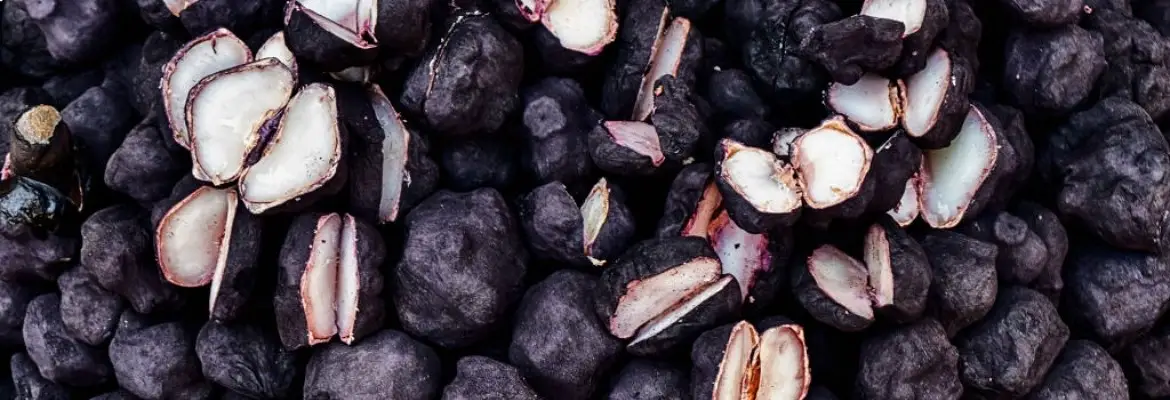Indian water chestnuts have to distinct horn like spines and are native to Asia. Because of their unique shape resembling a bat, they are also known as batnut. (Another variety of water chestnut is Chinese water chestnut).
Indian waterchest nuts have rustic earthy smell. Water chestnut pods change from green to dark purple-black as they mature, and their smooth surface has shallow ridges. The flesh of Indian water chestnut is white in color which is fibrous in texture.
It is advisable to cook the caltrop before consumption as raw flesh might be toxic. After cooking, the white flesh develops a starchy and crumbly texture (similar to that of a potato). The flesh has a musky sweet flavor profile.
Average size of Indian water chest nut / water caltrop is about 7 cm (2.7 inches).
Scientific name of Indian Water Chestnuts
Eleocharis Dulcis
Other names of Indian Water Chestnuts
- Singhara
- Water Caltrop
- Waternut
- Bullnut
- Batnut
- Ling nut
- Devil’s pod
- Chinese Horn Nut
Nutrition facts of Indian Water Chestnuts
*Serving size = 100 grams = 3.55 Ounces = 1/2 cup
*DV= % Daily Value (%DV indicates how much nutrients contribute to a person’s daily diet from a serving of a food. DV assists you in determining whether or not a serving of food is high or low in a particular nutrient.)
| Nutrient | Amount | Unit |
|---|---|---|
| Calories | 96 | KCAL |
| Fat | 0.37 | GRAM |
| Protein | 0.86 | GRAM |
| Carbohydrate | 21.46 | GRAM |
| Fiber | 3.02 | GRAM |
Calories by source in Indian Water Chestnuts:
- Calories by carbohydrate in Indian Water Chestnuts = 94%
- Calories by fat in Indian Water Chestnuts = 2%
- Calories by protein in Indian Water Chestnuts = 4%
Fats and Fatty Acid profile of Indian Water Chestnuts:
- Polyunsaturated fat (PUFA) in Indian Water Chestnuts = 35%
- Saturated fat (SFA) in Indian Water Chestnuts = 29%
- Monounsaturated fat (MUFA) in Indian Water Chestnuts = 36%
Detailed vitamin profile of Indian Water Chestnuts, vitamin A, vitamin B12, vitamin B6, vitamin C, vitamin D, Folate, Niacin, Thiamin, and Riboflavin is shown in the chart at the end of the article.
Detailed mineral profile of Indian Water Chestnuts, Sodium(Na), Calcium(Ca), Copper(Cu), Iron(Fe), Magnesium(Mg), Selenium(Se), Phosphorus(P), Potassium(K) and Zinc(Zn) is shown the chart at the end of the article.
Check freshness in Indian Water Chestnuts
- Select Indian water chestnuts which are rock hard
- Avoid a water chestnut with greenish undertone
- Avoid water chestnuts with bruises on the outer shell
Availability of Indian Water Chestnuts
- Best season is autumn through early winter
How to store Indian Water Chestnuts
- Unpeeled Indian water chestnuts can be stored in refrigerator for up-to 1 weeks (in a ventilated container)
- Peeled and cut Indian water chestnut can be stored in refrigerator for 2-3 days (in a sealed container)
- keep the pieces of Indian water chestnut submerged in water to avoid browning
Complete nutrition facts of Indian Water Chestnuts
Click on the link HERE to download high quality, high resolution and print ready PDF version of the Indian Water Chestnuts nutrition chart/infographic.



